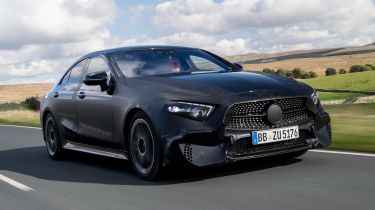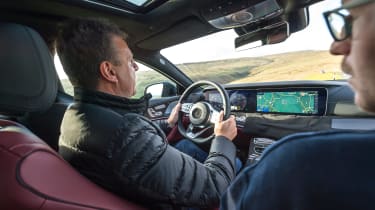New Mercedes CLS prototype ride review
On the road in the sleeker four-door Mercedes CLS coupe ahead of its LA show debut
It’s the Mercedes CLS’s blend of comfort and technology that impressed us from the passenger seat. And even with the heavy disguise you can tell this four-door coupe is shaping up to be one handsome car.
The original 2004 Mercedes CLS created a new niche, carving out the four-door coupe sector with its elegant styling and sportier set-up. It’s these elements that Mercedes has elevated to the next level with the third-generation CLS – and we’ve sampled a final pre-production car from the passenger seat in the UK. Here is our verdict ahead of the model’s global debut in November at the LA Motor Show.
This CLS marks the introduction of the new Mercedes 242bhp 2.0-litre four-cylinder petrol engine, but it was the 3.0 straight-six petrol and diesel models we experienced during our ride. The 3.0-litre petrol boasts advanced tech for the brand, too; a new 48V electrical system allows an integrated starter-alternator to deliver a 27bhp hit as part of the new EQ Boost system, totalling 362bhp. These cars can also coast with the engine off to help efficiency.
On the road, that extra boost was noticeable at low speed, helping to fill in the torque gap until the petrol engine’s turbo was on song. In our test car it revved sweetly with a muted, creamy rasp in Sport+ mode. The nine-speed gearbox is carried over from the E-Class, albeit with recalibrated software here. It shifted nicely, with snappy changes in manual mode and Mercedes’ usual smooth and ultra-refined auto changes in comfort.
The in-line six-cylinder diesels will come in 282bhp CLS 350 d and 335bhp 400 d forms. With diesel it’s all about the torque, so the respective 600Nm and 700Nm mean there’s plenty on tap to match rivals.
Used - available now

2022 Peugeot
E-2008
17,336 milesAutomaticElectric
Cash £13,400
2021 Peugeot
2008
9,432 milesManualPetrol1.2L
Cash £15,100
2023 Jaguar
I-PACE
23,066 milesAutomaticElectric
Cash £21,697
2024 Kia
Stonic
18,073 milesAutomaticPetrol1.0L
Cash £15,002In 350 d guise the engine felt muscular, with more than enough low-down torque and a suitably subdued rumble, as well as genuine S-Class levels of refinement. A Comfort package with double glazing will be available, and even on 19-inch wheels road noise was nicely suppressed.
The new CLS was comfortable, too, thanks to the extra torsional rigidity of the MRA platform it shares with the E-Class. Three suspension set-ups will be available: passive dampers with steel springs, adaptive dampers and the air suspension system fitted to this test car.
Elements have been tweaked to deliver a target balance of ride comfort with a sportier edge. However, our car felt geared towards the former, with plenty of compliance and a soft but controlled ride. On big wheels over harsh bumps it was a bit unsettled, but the chassis lost composure only a few times on very challenging roads.
The E-Class’s steering has been carried over with no adjustment. Michael Kelz, CLS chief engineer, told us: “It’s something we’re particularly proud of, and we saw no need to change or make it any more direct as it’s not our philosophy.”
Plenty of fancy S-Class features have been adopted, including Energizing Comfort Control – a package that offers different music, climate and massage-seat settings depending on your mood. It also alters the ambient lighting, while the colours of the air-vent surrounds reflect changes in temperature. Autonomous tech will be updated as well, with an improved stop-go traffic function and an overtaking assistant.










